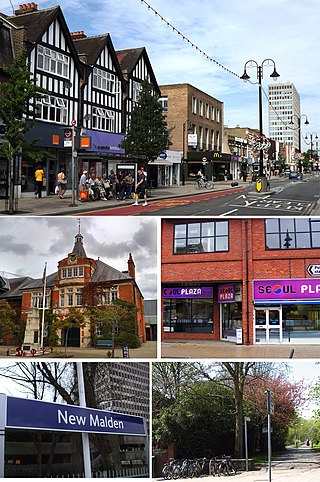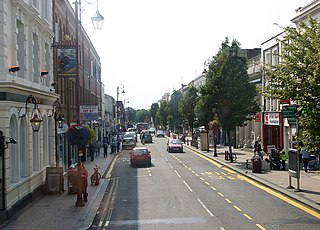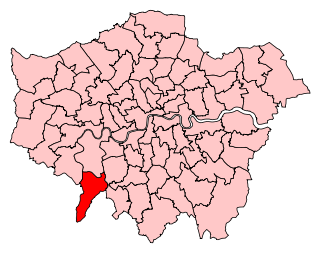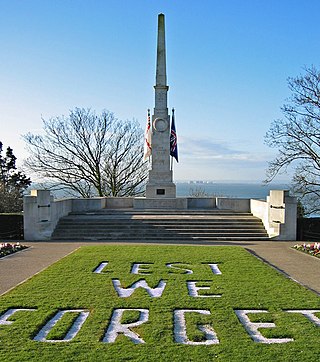
Kingston upon Thames, colloquially known as Kingston, is a town in the Royal Borough of Kingston upon Thames, south-west London, England. It is situated on the River Thames, 10 miles (16 km) south-west of Charing Cross. It is an ancient market town, notable as the place where some Saxon kings were crowned.

New Malden is an suburban area in South West London, England. It is within the Royal Borough of Kingston upon Thames and the London Borough of Merton, and is 9.4 miles (15.1 km) from Charing Cross. Neighbouring localities include Kingston, Norbiton, Raynes Park, Surbiton, Tolworth, Wimbledon, Old Malden, and Worcester Park. Prior to the creation of Greater London in 1965, New Malden was in the administrative county of Surrey.

The Royal Borough of Kingston upon Thames is a borough in southwest London. The main town is Kingston upon Thames and it includes Chessington, Malden Rushett, New Malden, Surbiton and Tolworth. It is the oldest of the four royal boroughs in England. The others are Windsor and Maidenhead, the site of Windsor Castle, and the London boroughs of Greenwich, and Kensington and Chelsea. The local authority is Kingston upon Thames London Borough Council.

Surbiton is a suburban neighbourhood in South West London, within the Royal Borough of Kingston upon Thames (RBK). It is next to the River Thames, 11 miles (18 km) southwest of Charing Cross. Surbiton was in the historic county of Surrey and since 1965 it has been in Greater London. Surbiton comprises four of the RBK's wards: Alexandra, Berrylands, St. Mark's, and Surbiton Hill.

Coombe is a historic neighbourhood in the Royal Borough of Kingston upon Thames in south west London, England. It sits on high ground, east of Norbiton. Most of the area was part of the former Municipal Borough of Malden and Coombe before local government re-organisation in 1965. It now shares borders with the boroughs of Merton and Sutton with, to the north, the small, inter-related neighbourhoods of Kingston Hill and Kingston Vale, beyond which is Richmond Park in Richmond; and Roehampton/Putney Vale in Wandsworth. To the east are public playing fields and Wimbledon Common.

Kingston and Surbiton is a constituency in Greater London created in 1997 and represented in the House of Commons of the UK Parliament since 2017 by Ed Davey, the Leader of the Liberal Democrats. Davey previously held the seat from 1997 until losing reelection in 2015 to Conservative James Berry.

Kingston-upon-Thames was a local government district in north east Surrey, England from 1835 to 1965 around the town now known as Kingston upon Thames. It was alternatively known as Kingston on Thames. It was a municipal borough and also held the rarer status of Royal borough. The district was abolished in 1965 and was replaced with the larger London Borough of Kingston upon Thames in Greater London, with the Royal borough status passed to the new district.

The National Submariners' War Memorial is a war memorial on the Victoria Embankment in London, England, between Waterloo Bridge and Blackfriars Bridge. The memorial is also referred to as the National Submarine War Memorial, the National Submarine Memorial, the Submarine War Memorial and the Submariner Memorial. It commemorates the Royal Navy submariners who died in the First and Second World Wars. The Royal Navy Submarine Service had 57 operational vessels at the start of the First World War in 1914, but expanded to 137 vessels by the time the war ended in 1918, with another 78 under construction. During the war, 54 of its submarines were sunk, and over 1,300 Royal Navy submariners were killed. The memorial is a Grade II* listed building, and it is the focal point of a special memorial walk and laying of wreaths held each year by submariners on the Sunday preceding Remembrance Sunday.

The Kingston upon Thames Guildhall is a municipal building in Kingston upon Thames in England. It is situated in the High Street, adjacent to the Hogsmill River. The guildhall, which is the headquarters of Kingston upon Thames London Borough Council, is a Grade II listed building.

The Royal Fusiliers War Memorial is a memorial in London, dedicated to the members of the Royal Fusiliers killed in the World Wars, Russian Civil War and subsequent conflicts, along with members of a number of London Regiment battalions killed in the First World War. It consists of a bronze statue on a 16.5 feet (5.0 m) pedestal made of Portland stone.

The Anglo-Belgian Memorial, also known as the Belgian Gratitude Memorial, Belgian Refugees Memorial, or the Belgian Monument to the British Nation, is a war memorial on Victoria Embankment in London, opposite Cleopatra's Needle. It was a gift from Belgium, as a mark of thanks for assistance given by the UK during the First World War, and in particular for sheltering thousands of Belgian refugees who fled from the war. It is a Grade II* listed building.

Richmond Cemetery is a cemetery on Lower Grove Road in Richmond in the London Borough of Richmond upon Thames, England. The cemetery opened in 1786 on a plot of land granted by an Act of Parliament the previous year. The cemetery has been expanded several times and now occupies a 15-acre (6-hectare) site which, prior to the expansion of London, was a rural area of Surrey. It is bounded to the east by Richmond Park and to the north by East Sheen Cemetery, with which it is now contiguous and whose chapel is used for services by both cemeteries. Richmond cemetery originally contained two chapels—one Anglican and one Nonconformist—both built in the Gothic revival style, but both are now privately owned and the Nonconformist chapel today falls outside the cemetery walls after a redrawing of its boundaries.

Southend-on-Sea War Memorial, or Southend War Memorial, is a First World War memorial in Southend-on-Sea, Essex, in south-eastern England. It was designed by Sir Edwin Lutyens and unveiled in 1921. Southend-on-Sea is a seaside resort famous for its pleasure pier, which was used by the military during the First World War. The town was a stopping point for soldiers en route to the front and, as the war drew on, it also became an important disembarkation point for the evacuation of injured troops. This saw the conversion of several buildings in Southend into hospitals.

St Saviour's War Memorial is a war memorial on Borough High Street, in the former parish of Southwark St Saviour, to south of the River Thames in London. It became a Grade II listed building in 1998 and was upgraded to Grade II* in 2018.

The principal war memorial in Enfield Town is the cenotaph that stands in Chase Green Gardens and is a grade II listed monument with Historic England. It commemorates men lost in both the World Wars as does a plaque in the town's main post office. In addition, in 2003 a memorial to those lost in the Arctic campaign of the Second World War was unveiled.

St Michael Cornhill War Memorial is a First World War memorial by the entrance to the church of St Michael Cornhill, facing Cornhill in the City of London. The memorial became a Grade II* listed building in December 2016 ; the church itself is Grade I listed.

Twickenham War Memorial, in Radnor Gardens, Twickenham, London, commemorates the men of the district of Twickenham who died in the First World War. After 1945, the memorial was updated to recognise casualties from the Second World War. The memorial was commissioned by Twickenham Urban District Council in 1921. It was designed by the sculptor Mortimer Brown, and is Brown's only significant public work. The memorial is unusual for its representation of a jubilant soldier returning home. It became a Grade II* listed structure in 2017.

Kingston upon Thames War Memorial, in the Memorial Garden on Union Street, Kingston upon Thames, London, commemorates the men of the town who died in the First World War. After 1945, the memorial was updated to recognise casualties from the Second World War. The memorial was commissioned by the town council and was designed by the British sculptor Richard Reginald Goulden. The memorial includes a bronze statue of a nude warrior, carrying a flaming cross and wielding a sword with which he defends two children from a serpent, erected on a granite plinth, with bronze plaques listing the names of the dead. Goulden designed a number of such allegorical memorials, including others at Crompton, Greater Manchester, and Redhill, Surrey. The Kingston memorial was designated a Grade II listed structure in 1983. This was revised upwards in 2016 to Grade II*, denoting a building or structure of particular importance.


















